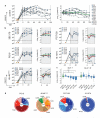HIV therapy by a combination of broadly neutralizing antibodies in humanized mice
- PMID: 23103874
- PMCID: PMC3809838
- DOI: 10.1038/nature11604
HIV therapy by a combination of broadly neutralizing antibodies in humanized mice
Abstract
Human antibodies to human immunodeficiency virus-1 (HIV-1) can neutralize a broad range of viral isolates in vitro and protect non-human primates against infection. Previous work showed that antibodies exert selective pressure on the virus but escape variants emerge within a short period of time. However, these experiments were performed before the recent discovery of more potent anti-HIV-1 antibodies and their improvement by structure-based design. Here we re-examine passive antibody transfer as a therapeutic modality in HIV-1-infected humanized mice. Although HIV-1 can escape from antibody monotherapy, combinations of broadly neutralizing antibodies can effectively control HIV-1 infection and suppress viral load to levels below detection. Moreover, in contrast to antiretroviral therapy, the longer half-life of antibodies led to control of viraemia for an average of 60 days after cessation of therapy. Thus, combinations of potent monoclonal antibodies can effectively control HIV-1 replication in humanized mice, and should be re-examined as a therapeutic modality in HIV-1-infected individuals.
Figures



References
Publication types
MeSH terms
Substances
Grants and funding
LinkOut - more resources
Full Text Sources
Other Literature Sources
Medical

